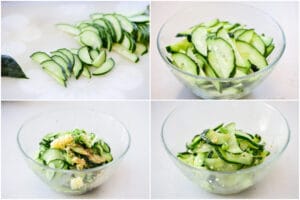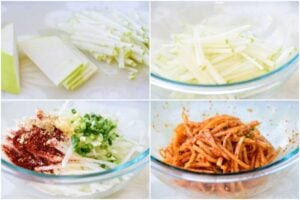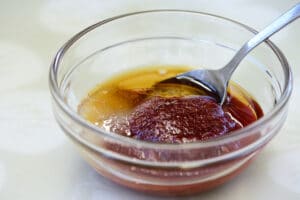Bibimbap
Bibimbap is a Korean rice bowl topped with vegetable sides and meat and served with a gochujang sauce. Follow my easy step-by-step recipe to make the best bibimbap!
Servings: 4 servings
Ingredients
Rice:
- 3 cups short grain rice
Meat:
- 8 ounces thinly sliced tender beef (rib eye, sirloin, etc. or ground beef)
- 1.5 tablespoons soy sauce
- 2 teaspoons sugar
- 2 teaspoons sesame oil
- 2 teaspoons cooking rice wine (Mirin or Mirim)
- 1 teaspoon minced garlic (This recipes needs 2.5 teaspoons minced garlic in total. Mince it all at once for efficiency.)
- 1 tablespoon chopped scallion (This recipe needs 4 tablespoons, 1 or 2 scallions depending on the size, in total. Chop them all once for efficiency.)
- pepper to taste
Vegetables and eggs:
- 8 ounces mung bean sprouts (sukju, 숙주) or soybean sprouts (kongnamul, 콩나물) - see more vegetable options below.
- 1 bunch spinach, about 8 ounces
- 2 small cucumbers, about 5 ounces
- 4 ounces mushrooms (shiitake, white, cremini, etc.)
- 2 medium carrots, about 5 ounces
- 1.5 teaspoons minced garlic, divided
- 3 3 tablespoons chopped scallion, divided
- sesame oil
- sesame seeds
- salt
- 4 eggs - optional
- cooking oil
More vegetable options
- 8 ounces Kongnamul (soybean sprouts)
- 10 ounces mu (Korean radish)
Bibimbap sauce
- 4 tablespoons gochujang, 고추장
- 2 teaspoons sugar - adjust to taste, 1-3 teaspoons
- 1 tablespoon sesame oil
- 1 tablespoon water
Instructions
Rice:
- Cook the rice, without soaking and using a little less water than the amount you normally use. The rice for bibimbap should be a little drier than usual for best results.

Meat:
- Beef: Cut into thin 2-inch long strips. Mix in 1.5 tablespoons of soy sauce, 2 teaspoons of sugar, 2 teaspoons of sesame oil, 2 teaspoons of rice wine, 1 tablespoon of chopped scallion, 1 teaspoon minced garlic, 1/2 sesame seeds and a pinch of pepper. Marinate for 20 minutes. Sauté in a skillet for 2-3 minutes over high heat.

Vegetables:
- Bean sprouts: Bring 2 cups of water to a boil. Add the bean sprouts and briefly blanch, about 1 minute, flipping over once. Drain quickly and shock in cold water to stop cooking. Drain again. Toss with 1/2 teaspoon of minced garlic, 1 teaspoon of sesame oil, 1/2 teaspoon of sesame seeds, and salt (about 1/2 teaspoon).

- Spinach: Blanch the spinach in salted boiling water only until wilted, about 40 seconds. Drain quickly and shock in cold water. Squeeze out water. Cut into 3-inch lengths. Toss with 1 tablespoon of chopped scallion, 1/2 teaspoon minced garlic, 1 teaspoon of sesame oil, 1/2 teaspoon of sesame seeds and salt (about 1/2 teaspoon).

- Cucumbers: Cut the cucumbers in half lengthwise and then thinly slice crosswise. Generously sprinkle salt (about 1/2 teaspoon) over sliced cucumbers and set aside for 10 - 15 minutes. Squeeze out excess liquid. Toss with 1 tablespoon of chopped scallion, 1/2 teaspoon minced garlic, 1 teaspoon sesame oil and 1/2 teaspoon of sesame seeds.

- Mushrooms and carrots: Thinly slice the mushrooms and carrots. Sauté each vegetable in a lightly oiled skillet for 1 - 2 minutes over medium-high heat, sprinkling with salt (about 1/4 teaspoon).

More vegetable options:
- Kongnamul (Soybean sprouts): Bring 2 cups of water to a boil. Add the soy beansprouts and boil for 2-3 minutes. Drain quickly and shock in cold water to stop cooking. Drain again. Toss with 1/2 teaspoon of minced garlic, 1 teaspoon of sesame oil, 1/2 teaspoon of sesame seeds, and salt (about 1/2 teaspoon) to taste.

- Musaengchae (spicy radish salad): Cut 10 ounces of Korean radish (mu) into matchsticks. Add 2 tablespoons of chopped scallion, 1 tablespoon of gochugaru, 1 teaspoon minced garlic, 1/2 teaspoon salt (or more to taste), 1 teaspoon sugar, and 1 teaspoon sesame seeds. Mix everything well.

Optional Eggs:
- Fry the eggs sunny side up or to your preference.

Bibimbap sauce:
- Combine all of the sauce ingredients in a small bowl and mix thoroughly.

Assembling:
- Place a serving of rice in a big bowl. Nicely arrange a small amount of each prepared vegetable and beef over the rice. Drizzle a little sesame oil over. Top with an optional fried egg and serve with the sauce.
- For dolsot bibimbap: Lightly oil a stone or earthenware bowl with a teaspoon of sesame oil over medium heat. Add a serving of cooked rice and arrange the toppings on top. Cook for several minutes until the rice sizzles.

Notes
Other common bibimbap vegetables include zucchini, mu saengchae (radish salad), onion (sliced and sautéd), bellflower roots (doraji - soaked and sautéd), gosari (fiddlehead ferns), lettuce leaves, red cabbage, kimchi, gim (roasted seaweed sheet, aka nori) and so on. Also see my collection of 15 Korean vegetable side dishes for more options.
